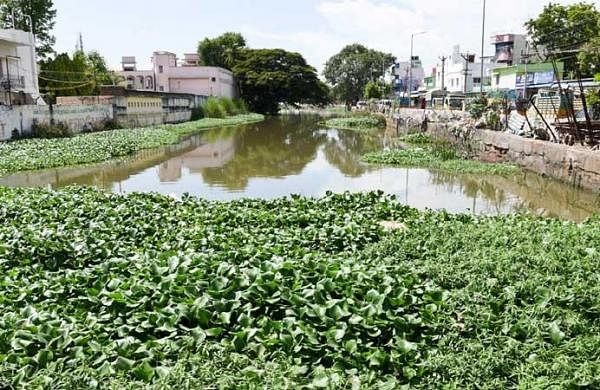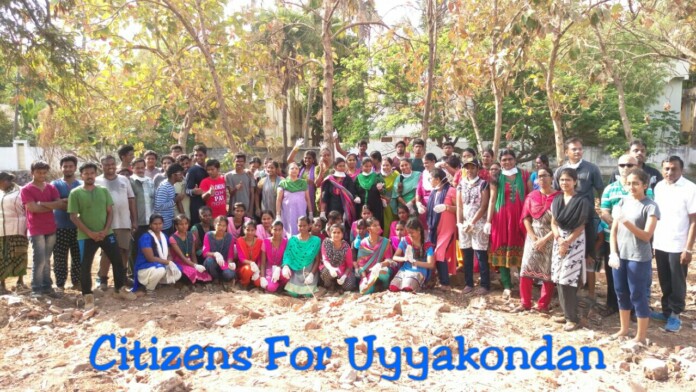It’s a motley group of people of Trichy who have been doing little things on their own, to make people see what they need to do, to overcome the challenge of water conservation and supply. You stand on the banks of the river Cauvery or of the Kollidam [the colonial Coleroon], and you wonder if there is at all a challenge of water in this ancient town of temples and of some of the finest schools and colleges.
When the citizens for Uyyakondan banded together in 2015, not many were interested. Most people shrugged, “Where is any challenge of water? What is the issue that you want to take up when there is none at all?!” Dr Narasimha Rao, an orthopaedic, in his usual silent ways, chose not to react. He persisted. The forum grew into a sizeable number of people. They first put signboards on the history of the canal, the benefits accruing from the UK canal. Hope was that people would read them, know the significance, and do their little bit to reduce abuse of the canal. The polluting of the canal and of the lake of Uyyakondan is massive. How do we get people to stop polluting what was originally a freshwater body?
Bridge Foundation that Dr Narasimha Rao had founded, continued its bit to nudge the story along, and bring subtle but tangible behavioural change wherever possible. When they hit upon WOW Action Forum and the work that the national and global group of water and sustainability experts were doing, Trichy saw promise. They chose to make their city a WOW Partner City, and galvanised a few citizen leaders from the town to join in. Says Narasimha, the Mission Director, “We must first bring some demonstrated change with higher education institutions, or industry, or even apartments and such communities which use water in large quantities. Then we can prove how the solutions bring measurable and dramatic savings.” Says WOW’s national forum founder, Dr Hariharan, “Every school or college campus of one acre, with 1000 children, with the city receiving one metre or 1000 mm of rainfall, can generate one crore litres of water in one year…. With very simple water solutions that are installed for both harvesting water, and for saving water with efficient fixtures and systems.”
Ar. Vijay Sengottavan, a practising professional, and a pleasant, thinking citizen who has gained the respect and the ears of the City’s administration over years of dedicated contribution he has made for the town, says, “The Big Institutions in Trichy have a vital role. Large institutions and the government, in my opinion, must be targets. I believe that reusing water is more vital than rainwater gathering. The government promises 100 litres of water to each person and somehow manages to provide it. So, when it comes to larger institutions with a higher number of individuals, this is most often the case.
Water Reuse Potential
Water reuse is one solution to the problem. As a result, I believe that after the larger institutions have brought such savings in their freshwater demand, the government will be in a better position to provide for the less fortunate members of society. It is the responsibility of major institutions to take the initiative; let us begin with them in Trichy. Let us work to overcome mindsets and preconceptions at the bottom level that it will take time, money, and effort. We had Kaveri’s waters meeting our needs up until now, and we weren’t in too bad a shape. The future is not very reassuring.”
Adds Narasimha, “In contrast to Bangalore, I am yet to encounter a crisis scenario in which we must pay for the amount of water used by a person, apartment, house, or institution. A fixed water cess must be paid for a slab of water use. Yes, there are areas in Trichy where people buy water from tanks, but it’s not terribly expensive. It’s not like Trichy is experiencing a severe water shortage. Due to initiatives to create a water channel in Trichy, there is a growing level of awareness. The issue we have is that we need to understand how to treat our wastewater, which is the primary source of contamination in Trichy’s largest freshwater lake, the Uyyakondan. Individual homes as well as bulk water-users discharge waste water into this channel. Question is : how do we handle sewage on a small scale as well as large scale? Individuals who are interested should be offered solutions on a scale that they can adapt to, while institutions ready to do their part on a larger scale, such as Holy Cross College, should be offered solutions on a larger scale. They are ready and willing–if the solution directions are guided. This is where WOW professionals can step in and guide the city’s challenge.”
Save Uyyakondan Lake

Reflects Ar Vijay, “The 1000-year old Uyyakondan Canal which once was a life-support for Trichy’s water needs, has suffered the last 3 decades, massive abuse from water-users. Sewage enters the canal at several points with really no check or monitor. Officers in the administration say that installing water treatment systems before the waste water enters the Canal is not viable. “We cannot maintain and operate it in numerous locations,” is the refrain. “There’s also a general debate over whether the solution should be central or localised to the point of water-discharge or source at which the waste water is generated. At the organisational or corporate level, they must install such water treatment systems, and assign individuals to manage maintenance.
“We seek decentralisation, while bureaucrats want it to be more centralised. There are some inspiring examples. Railways, for example, do an excellent job of recycling water. They are major landowners in Trichy. Their example needs to be recognised by others and emulated by more bulk water-users in Trichy.” Echoes Narasimha, “Sure, we need decentralised treatment of waste water in homes and offices, hospitals and hotels… This will ensure discharge into the Uyyakondan canal – of about half the water so treated and reused by the buildings.”
Adds Vijay, “Such post STP treated water can be used to irrigate agricultural lands on the outskirts of the city if the drainage of the canal gains good treated water. We are not suggesting that such treated wastewater should be potable. It should be good enough for agricultural purposes.”
Based on excerpts from a conversation at the Prem Jain Memorial Trust Mahotsav Series. Healing of Trichy lake – https://youtu.be/t7R8mWUJxjw
Pallavi Singh & Lahari Babu Team WOW Action Forum.
a
Support Green Journalism
Dear Readers,
Since March 2013, SustainabilityNext (SN) has been educating and exciting thousands of entrepreneurs, executives and graduate students about the power of Sustainability in influencing our future. It’s purpose is to inspire and provoke Indians to move swiftly from awareness to belief to ACTION.
As of December 2021, SN is India’s most read digital magazine on the business of sustainability. It has been covering Green Business, Green Products, Social Entrepreneurship, Green Literature, Green Technology, among others. A youth section was added in 2021.
SN launched India’s first Green Literature Festival (www.greenlitfest.com) in June 2021 to offer a robust platform for readers and writers to hold meaningful conversations.
For SN to grow and stay relevant it needs to transition from a grant and self-funded model to a community-funded and/or institution/corporate-funded model.
Looking forward to your timely and generous support.
Why Support SN – https://sustainabilitynext.in/support/
Subscriber
Supporter
Benefactor
Sponsor
All supporters get two-year subscription to SN. You can Gift Subscription to your colleagues/friends/family.
For sponsorships and advertising please contact
Benedict Paramanand
Publisher & Editor
benedict99@gmail.com
a








